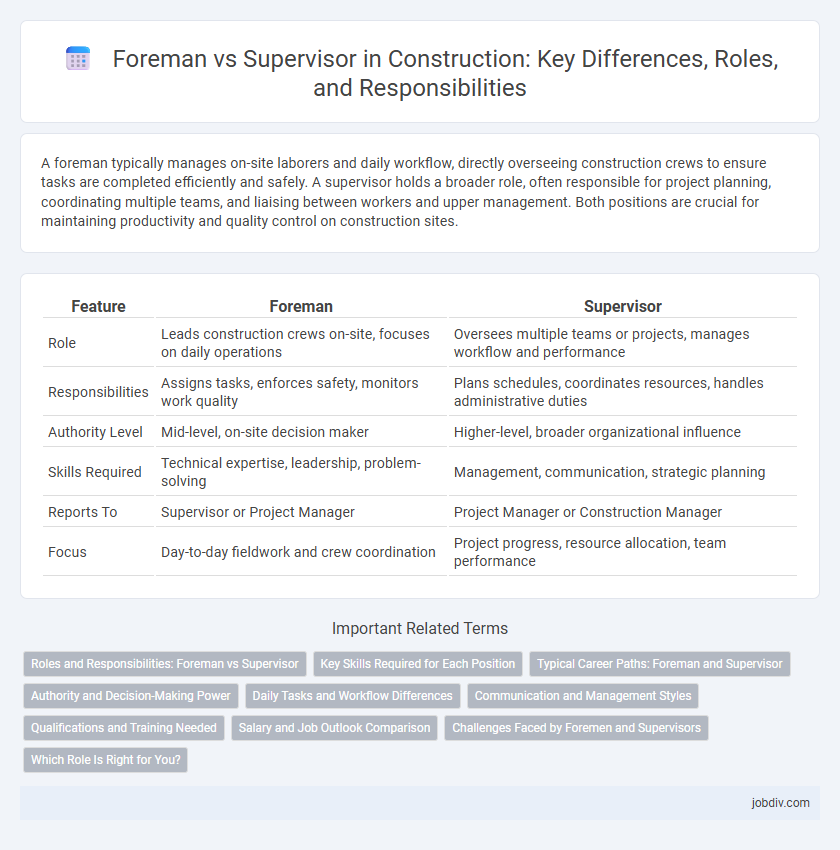A foreman typically manages on-site laborers and daily workflow, directly overseeing construction crews to ensure tasks are completed efficiently and safely. A supervisor holds a broader role, often responsible for project planning, coordinating multiple teams, and liaising between workers and upper management. Both positions are crucial for maintaining productivity and quality control on construction sites.
Table of Comparison
| Feature | Foreman | Supervisor |
|---|---|---|
| Role | Leads construction crews on-site, focuses on daily operations | Oversees multiple teams or projects, manages workflow and performance |
| Responsibilities | Assigns tasks, enforces safety, monitors work quality | Plans schedules, coordinates resources, handles administrative duties |
| Authority Level | Mid-level, on-site decision maker | Higher-level, broader organizational influence |
| Skills Required | Technical expertise, leadership, problem-solving | Management, communication, strategic planning |
| Reports To | Supervisor or Project Manager | Project Manager or Construction Manager |
| Focus | Day-to-day fieldwork and crew coordination | Project progress, resource allocation, team performance |
Roles and Responsibilities: Foreman vs Supervisor
Foremen oversee day-to-day operations on construction sites, managing crew tasks, ensuring safety compliance, and maintaining project schedules. Supervisors hold a broader role, coordinating multiple foremen, managing resources, enforcing quality standards, and communicating between site workers and upper management. Both roles are critical for efficient construction project execution, with foremen focused on direct labor supervision and supervisors overseeing overall site productivity and coordination.
Key Skills Required for Each Position
Foremen require strong technical knowledge of construction methods, excellent communication skills to coordinate teams, and the ability to manage daily site operations efficiently. Supervisors need advanced project management abilities, expertise in resource allocation, and comprehensive understanding of safety regulations to ensure overall site compliance. Both roles demand leadership qualities, problem-solving skills, and the capacity to maintain workflow and quality standards.
Typical Career Paths: Foreman and Supervisor
Foremen typically advance from skilled trades roles, leveraging hands-on experience to manage crews and coordinate daily tasks on construction sites. Supervisors often emerge from foreman positions or technical backgrounds, expanding their scope to oversee project schedules, budgets, and compliance with safety regulations. Both career paths offer progression to roles such as project manager or construction superintendent, emphasizing leadership, project management, and operational expertise.
Authority and Decision-Making Power
Foremen typically possess direct authority over on-site labor, managing day-to-day construction activities and ensuring compliance with project specifications. Supervisors hold broader decision-making power, overseeing multiple foremen, coordinating between various teams, and implementing higher-level project strategies. The supervisor's authority extends to resource allocation, schedule adjustments, and enforcing safety protocols, while the foreman's focus remains on tactical execution and immediate problem-solving.
Daily Tasks and Workflow Differences
Foremen oversee on-site crew performance, ensuring labor aligns with project specifications, while supervisors manage overall project workflow, resource allocation, and compliance adherence. Foremen focus on day-to-day task execution and direct crew coordination, whereas supervisors handle progress tracking, reporting, and resolving operational issues. Both roles are critical, but foremen center on hands-on labor management, and supervisors prioritize broader project oversight.
Communication and Management Styles
Foremen typically emphasize hands-on communication with crews, facilitating direct, real-time instructions and immediate problem-solving on construction sites. Supervisors often adopt a broader management style, coordinating multiple teams and leveraging formal communication channels to ensure project alignment and compliance with safety standards. Effective construction leadership balances the foreman's practical guidance with the supervisor's strategic oversight to optimize workflow and team productivity.
Qualifications and Training Needed
A construction foreman typically requires extensive hands-on experience in the trade, often supplemented by specific certification in safety and site management, reflecting a practical understanding of the work processes. Supervisors generally need formal education such as a degree or diploma in construction management or engineering, combined with leadership training and knowledge of regulatory compliance. Both roles demand continuous professional development, but supervisors focus more on project coordination and regulatory knowledge, whereas foremen emphasize technical skills and crew management.
Salary and Job Outlook Comparison
Foremen in construction earn an average annual salary ranging from $50,000 to $75,000, reflecting their hands-on leadership in managing on-site crews and daily operations. Supervisors typically command higher salaries, often between $65,000 and $90,000, due to their broader responsibilities in project oversight and compliance enforcement. Job outlook for both roles remains strong, with the Bureau of Labor Statistics projecting a 4% growth rate for construction supervisors through 2031, while foremen positions grow steadily in line with overall construction industry expansion.
Challenges Faced by Foremen and Supervisors
Foremen encounter challenges such as coordinating skilled labor, maintaining safety compliance, and managing time-sensitive project schedules, which require hands-on problem-solving and clear communication with crew members. Supervisors face difficulties in overseeing multiple teams, ensuring regulatory adherence, and balancing administrative duties like reporting and resource allocation to meet project deadlines. Both roles demand strong leadership skills to navigate workforce conflicts, control costs, and adapt to changing site conditions effectively.
Which Role Is Right for You?
A foreman typically manages on-site labor, ensuring tasks are executed efficiently and safety protocols are followed, while a supervisor oversees broader project operations, including coordination between teams and adherence to project timelines. Choosing the right role depends on your strengths; if you excel in hands-on leadership and direct workforce management, foreman suits you better, whereas strong organizational skills and strategic oversight align with a supervisor position. Understanding these distinctions can help construction professionals find the best fit for advancing their careers.
Foreman vs Supervisor Infographic

 jobdiv.com
jobdiv.com